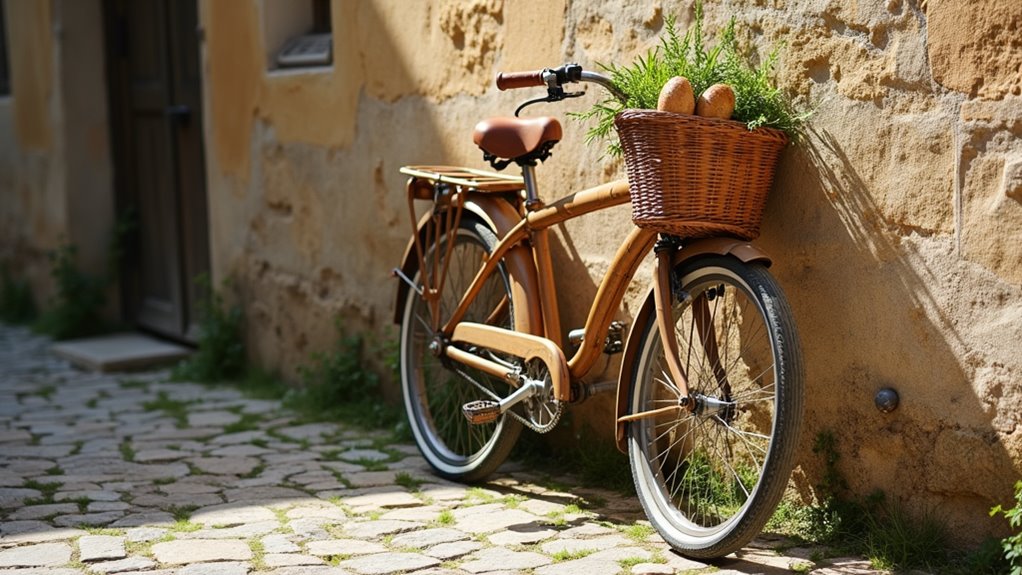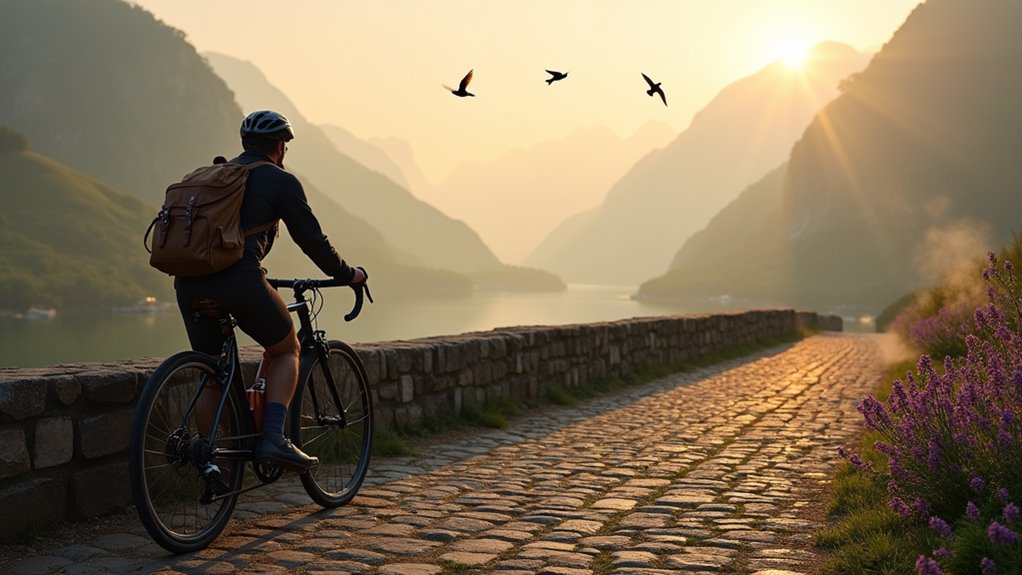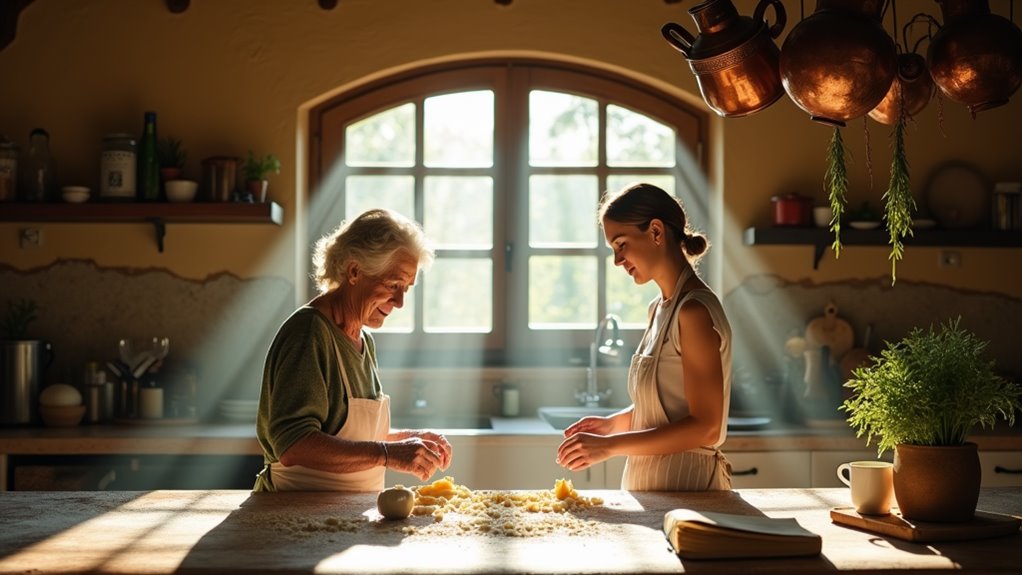Slow travel invites you to experience destinations on a deeper level by immersing yourself in local culture rather than rushing through tourist checkpoints. You'll stay longer in one place, shop at local markets, and build genuine connections with communities while reducing your carbon footprint. Instead of cramming attractions into a tight schedule, you can explore at your own pace, learn the language, and participate in daily life like a local. Choose accommodation in residential areas, use public transportation, and embrace authentic experiences through community events. This mindful approach to travel opens doors to discoveries you'd never find on a typical vacation.
Key Takeaways
- Immerse yourself in local culture by staying in one place longer, participating in community events, and engaging with residents.
- Choose accommodations in residential neighborhoods and shop at local markets to experience authentic daily life.
- Opt for sustainable transportation like walking, cycling, or public transit to minimize environmental impact and maximize local experiences.
- Travel during shoulder seasons to avoid tourist crowds and create genuine connections with destinations and communities.
- Document experiences through journaling and photography while maintaining a flexible schedule that allows for spontaneous discoveries.
What Makes Slow Travel Different

Unlike traditional tourism that rushes through destinations with packed itineraries, slow travel emphasizes immersing yourself in local culture and daily life.
You'll spend weeks or months in one location rather than days, allowing you to develop authentic connections with residents and understand their way of life.
Instead of racing between tourist attractions, you'll shop at local markets, learn the language basics, and discover hidden gems off the beaten path.
You might rent an apartment, cook regional dishes, or join community events.
The focus shifts from checking items off a list to experiencing a place's genuine rhythm and character.
This mindful approach to travel reduces your environmental impact while creating meaningful memories through genuine cultural exchange and personal growth.
Benefits of Taking It Slow
When you embrace slow travel, you'll forge meaningful connections with local communities by spending more time in one place.
You'll have opportunities to learn customs firsthand, practice the language, and participate in daily life rather than rushing through tourist highlights.
Moving at a relaxed pace also means you won't feel exhausted from constant packing and unpacking, letting you actually enjoy your journey instead of racing against time.
Deeper Cultural Connections
By embracing a slower pace of travel, you'll forge meaningful connections with local communities that simply aren't possible during rushed vacations.
When you spend more time in one place, you can join local events, chat with neighborhood shopkeepers, and learn about daily life from residents.
You'll discover favorite cafes where servers remember your name, find hidden spots that tourists rarely see, and pick up local customs naturally.
Instead of just photographing a culture, you'll participate in it. You might learn to cook traditional dishes, practice the language with neighbors, or celebrate local festivals.
These authentic experiences help you understand the heart of a destination, transforming you from an observer into a temporary local who truly appreciates the community's values and way of life.
Reduced Travel Stress
Traditional fast-paced tourism often leaves travelers exhausted and overwhelmed, but slow travel eliminates these common stressors.
When you're not rushing from one attraction to another, you'll find yourself breathing easier and truly relaxing into your surroundings.
By staying in one location longer, you won't need to constantly pack and unpack or worry about catching trains and flights. You'll have the freedom to create a comfortable routine, sleep in when you want, and explore at your own pace.
There's no pressure to tick off every tourist spot or fill each moment with activity.
You'll also avoid the anxiety of rigid itineraries and scheduling conflicts. Instead, you can embrace spontaneity, take detours, and adjust your plans based on how you feel each day.
Choosing Your Perfect Destination

How do you find that perfect destination for your slow travel journey? Start by identifying places that align with your interests and travel pace.
Consider destinations with rich cultural heritage, walkable neighborhoods, and opportunities for meaningful local interactions.
Look for locations that offer extended-stay accommodations and aren't overwhelmed by mass tourism. You'll want a place where you can blend into the local rhythm rather than rush through tourist checkpoints.
Research areas with good public transportation and pedestrian-friendly streets.
Weather and seasonal timing matter too. Choose a destination during its shoulder season when you'll find fewer crowds and more authentic experiences.
Most importantly, pick somewhere that sparks your curiosity and gives you space to explore, learn, and grow at your own unhurried pace.
Living Like a Local
When you embrace slow travel, immersing yourself in the local way of life becomes the heart of your journey. Shop at neighborhood markets, learn basic phrases in the local language, and spend time observing daily routines. You'll discover authentic experiences that tourists often miss.
Choose accommodations in residential areas rather than tourist zones. Visit local cafes regularly until the barista knows your usual order. Take public transportation instead of taxis, and don't shy away from striking up conversations with residents.
Join community events, cooking classes, or local sports activities. Remember that living like a local isn't about pretending to be one – it's about gaining genuine insights into the culture.
Take time to develop meaningful connections and create lasting memories beyond typical tourist experiences.
Mindful Transportation Methods

Choosing mindful transportation enriches your slow travel experience while reducing environmental impact.
You'll discover local rhythms by taking regional trains through scenic countryside routes or riding public buses alongside residents. Walking and cycling let you explore hidden corners and stumble upon authentic experiences that rushed tourists miss.
Consider using water transportation when available – river ferries, canal boats, or local water taxis offer unique perspectives of your destination.
If you need to rent a vehicle, opt for electric or hybrid options, and plan longer stays in each location to minimize transit time.
When you must fly, choose direct routes and offset your carbon footprint.
These thoughtful transportation choices help you connect more deeply with places and people while practicing sustainable tourism.
Connecting With Local Communities
When you embrace local life, you'll shed the tourist label and begin to understand a destination's true rhythms and routines.
You can start by staying in residential neighborhoods, shopping at local markets, and adopting daily customs that match the community's pace.
Even if you don't speak the language fluently, you'll find that genuine smiles, respectful gestures, and basic greetings can help forge meaningful connections with residents.
Living Like Locals
To truly embrace slow travel, immersing yourself in local communities transforms your journey from a typical tourist experience into authentic cultural exchange.
You'll find deeper meaning by adopting local routines, shopping at neighborhood markets, and preparing regional dishes in your rented apartment.
Start your day at the corner café where residents gather, practice the local language with shopkeepers, and explore hidden spots that aren't in guidebooks.
Take public transportation instead of tourist buses, and you'll discover how people actually live. Join community events, attend local festivals, and accept invitations to family gatherings when offered.
Consider volunteering or taking classes in traditional crafts to connect more meaningfully with the culture.
These everyday experiences help you develop a genuine understanding of your destination's rhythm and soul.
Breaking Language Barriers
Language barriers shouldn't stop you from connecting with locals during your slow travel journey. Learn basic greetings and everyday phrases in the local language to show respect and create genuine connections.
Even simple words like "hello," "thank you," and "please" can open doors to meaningful interactions.
Keep a translation app handy, but don't rely on it exclusively. Use gestures, facial expressions, and body language to communicate. Draw pictures if needed, or point to objects to convey your meaning. Many locals appreciate your efforts to speak their language, even if you make mistakes.
Consider taking informal language classes at local cafes or joining language exchange meetups. These gatherings often lead to friendships and deeper cultural understanding, transforming potential barriers into bridges between cultures.
Sustainable Travel Practices

Sustainability lies at the heart of slow travel's philosophy. When you choose to travel slowly, you're naturally reducing your carbon footprint by taking fewer flights and opting for more eco-friendly transportation like trains and buses.
You'll find yourself supporting local economies by staying in family-run guesthouses and dining at neighborhood restaurants.
Make conscious choices to minimize your environmental impact. Carry a reusable water bottle, shop at local markets, and avoid single-use plastics.
Consider offsetting your unavoidable carbon emissions through verified programs. By staying longer in each destination, you'll use fewer resources than constantly moving between places.
You can also participate in local conservation efforts or volunteer with environmental organizations, turning your journey into a force for positive change.
Planning Your Extended Stay
Setting up an extended stay requires thoughtful planning across five key areas: accommodation, daily routines, work arrangements, local connections, and budget management.
Start by securing a comfortable long-term rental that's well-connected to local amenities and transport. You'll want to establish a sustainable daily rhythm that blends work, exploration, and rest.
If you're working remotely, ensure reliable internet connectivity and set up a proper workspace.
Make an effort to build relationships with locals through community events, language exchanges, or shared interests. You'll gain authentic insights and meaningful connections that enhance your experience.
Finally, create a realistic monthly budget that accounts for housing, utilities, food, transport, and leisure activities.
Don't forget to include a buffer for unexpected expenses and local experiences you won't want to miss.
Cultural Immersion Techniques

While exploring a new destination, true cultural immersion requires active participation in local life. You'll connect more deeply with a place by shopping at neighborhood markets, taking public transportation, and frequenting local cafes rather than tourist spots.
Learn basic phrases in the local language and use them daily, even if you make mistakes.
Seek out community events, festivals, and cultural celebrations where you can observe and participate in traditions firsthand.
Consider taking classes in local crafts, cooking, or dance to gain hands-on experience.
Strike up conversations with residents at parks, libraries, or community centers. You'll find that most people appreciate your genuine interest in their culture and are willing to share their perspectives, creating meaningful cross-cultural connections that enrich your travel experience.
Creating Meaningful Travel Memories
These authentic cultural experiences form the foundation for lasting travel memories. By engaging deeply with local life, you'll create moments that resonate long after your journey ends.
Document your experiences through journaling, sketching, or photography, but remember to stay present in the moment rather than viewing everything through a lens.
Connect with locals and fellow travelers by sharing meals, stories, and everyday activities. You'll find that some of your most treasured memories come from unexpected encounters and spontaneous conversations.
Save meaningful objects like train tickets, local artwork, or handwritten recipes that trigger specific memories. Consider creating a digital or physical travel diary that combines your observations, collected items, and reflections.
These personal artifacts will help you relive your slow travel experiences for years to come.
Frequently Asked Questions
How Much Extra Money Should I Budget for Unexpected Slow Travel Delays?
You'll want to set aside 15-20% of your total travel budget for unexpected delays. This buffer helps cover extra accommodation costs, alternative transportation, or emergency supplies.
If you're traveling long-term, aim for $50-100 per day in developed countries and $25-50 in developing regions.
Keep some funds easily accessible, and consider travel insurance for additional protection against major disruptions.
What Travel Insurance Policies Best Cover Extended Slow Travel Experiences?
You'll want a policy that covers long-term adventures without strict time limits.
World Nomads and Safety Wing stand out for their flexible coverage periods and renewable plans.
Look for policies offering extensive trip interruption, medical evacuation, and gear protection.
Don't forget to verify coverage for activities like hiking or volunteering.
Best yet, many comprehensive policies let you extend coverage mid-journey if your plans evolve.
How Do I Maintain Work Commitments While Practicing Slow Travel?
You'll need a reliable remote work setup with strong internet connectivity and a portable workspace.
Plan your schedule around time zones and maintain clear communication with colleagues. Set dedicated work hours and stick to them, even while traveling.
Consider staying in each location longer to establish a routine, and choose accommodations with good workspaces.
Use productivity apps to manage tasks and scheduling across different time zones.
Are There Age Restrictions or Physical Requirements for Slow Travel?
Like a meandering stream, slow travel adapts to your own pace and abilities.
You'll find there aren't any age restrictions or physical requirements – it's accessible to everyone.
Whether you're a senior with mobility concerns or a young family with strollers, you can tailor your journey to match your comfort level.
Just adjust your itinerary, choose suitable accommodations, and plan rest days that work for your needs.
How Do I Handle Medical Prescriptions During Long-Term Slow Travel?
You'll need to plan carefully for prescription medications during long-term travel.
Get a doctor's note explaining your prescriptions, bring copies of your prescriptions, and pack enough medication for your entire trip plus extra.
Store medications in original containers, keep them in your carry-on, and research local drug laws at your destinations.
Consider using international pharmacies that partner with your insurance provider for refills.
Conclusion
Isn't it ironic that you've spent all this time learning how to slow down, yet you're already racing to plan your next slow travel adventure? Take a breath. While everyone else rushes from landmark to landmark, you'll be sipping coffee at that hidden café, chatting with locals, and finally understanding what traveling really means. Sometimes the best way to see more is to do less.

Leave a Reply